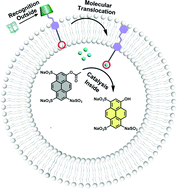Supramolecularly regulated artificial transmembrane signal transduction for 'ON/OFF'-switchable enzyme catalysis†
Abstract
An artificial signal transduction model with a supramolecular recognition headgroup, a membrane anchoring group, and a pro-enzyme catalysis endgroup was constructed. The transmembrane translocation of the transducer can be reversibly regulated by competitive host–guest complexations as an input signal to control an enzyme reaction inside the lipid vesicles.

- This article is part of the themed collection: Chemical Communications HOT Articles 2022


 Please wait while we load your content...
Please wait while we load your content...